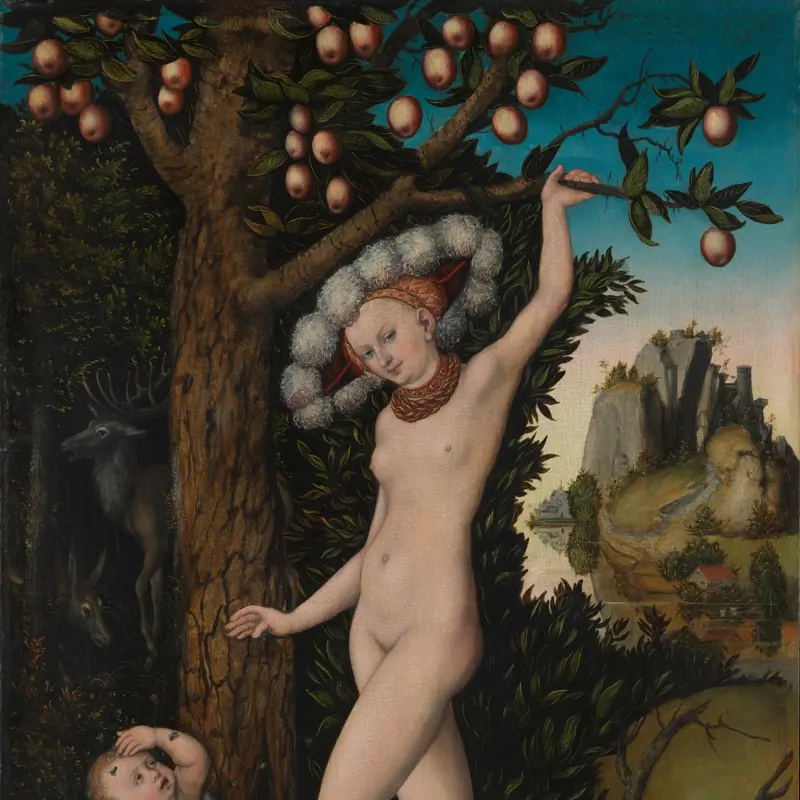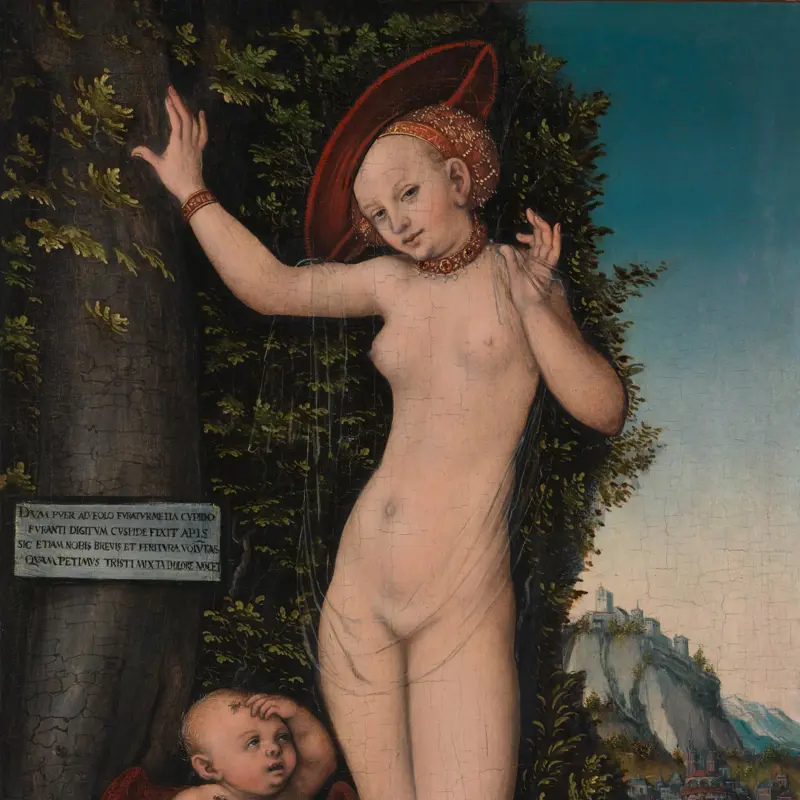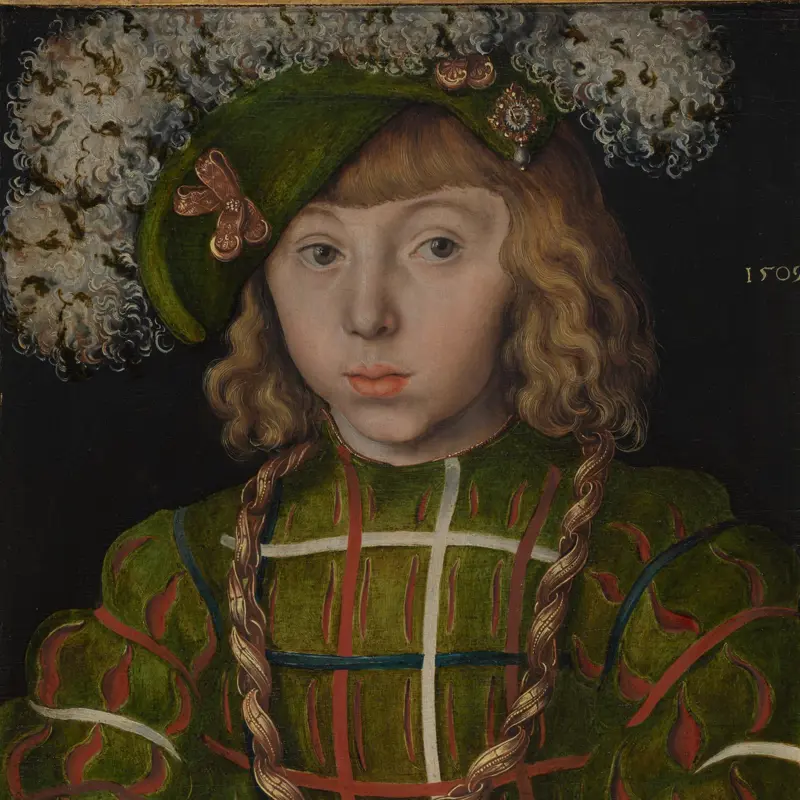Lucas Cranach the Elder, 'Portrait of a Woman', 1525-7
About the work
Overview
We don‘t know the identity of this woman dressed in sumptuous fabrics and heavy gold jewellery, but her clothing is like that worn by the elite of society and ladies of the Saxon court. Her outfit is, in parts, physically impossible: the rings she wears under her gloves are higher up her fingers than the ones she wears over them. Cranach has manipulated reality to emphasise her wealth and beauty.
The letter ’M' is fashioned in pearls across her bodice, suggesting that this is a portrait of a real person, but her facial features follow a generic, idealised perception of beauty. It has been suggested that this woman could have been a mistress of one of the electors of Saxony, and her features were deliberately generalised by Cranach.
Key facts
Details
- Full title
- Portrait of a Woman
- Artist
- Lucas Cranach the Elder
- Artist dates
- 1472 - 1553
- Date made
- 1525-7
- Medium and support
- Oil on wood (possibly beech)
- Dimensions
- 35.9 × 25.1 cm
- Inscription summary
- Signed
- Acquisition credit
- Bought, 1857
- Inventory number
- NG291
- Location
- Room 55
- Collection
- Main Collection
- Previous owners
- Frame
- 21st-century Replica Frame
Provenance
Additional information
Text extracted from the ‘Provenance’ section of the catalogue entry in Susan Foister, ‘National Gallery Catalogues: The German Paintings before 1800’, London 2024; for further information, see the full catalogue entry.
Exhibition history
-
2008Picasso et les MaîtresGaleries Nationales du Grand Palais8 October 2008 - 2 February 2009
-
2014Strange Beauty: Masters of the German RenaissanceThe National Gallery (London)19 February 2014 - 11 May 2014
-
2020Cranach: Artist and InnovatorCompton Verney14 March 2020 - 3 January 2021
Bibliography
-
1854G.F. Waagen, Treasures of Art in Great Britain: Being and Account of the Chief Collections of Paintings, Drawings, Sculptures, Illuminated Mss. […], vol. 2, trans. E. Eastlake, London 1854
-
1857Christie & Manson, Catalogue of the Magnificent Contents of Alton Towers, the Princely Seat of the Earls of Shrewsbury, London, 6 July 1857 - 8 August 1857
-
1932M.J. Friedländer and J. von Rosenberg, Die Gemälde von Lucas Cranach, Berlin 1932
-
1959Levey, Michael, National Gallery Catalogues: The German Schools, London 1959
-
1961L.D. Ettlinger, 'Reflections on German Paintings: Review of Michael Levey, the German School, 1959', The Burlington Magazine, CIII/697, 1961, pp. 132-8
-
1978M.J. Friedländer and J. von Rosenberg, The Paintings of Lucas Cranach, revised edn, London 1978
-
1985A. Smith, Early Netherlandish and German Paintings, London 1985
-
1993B. Hinz, Lucas Cranach D. Ä, Reinbek nr. Hamburg 1993
-
1997R. Billinge et al., 'Methods and Materials of Northern European Painting in the National Gallery, 1400-1550', National Gallery Technical Bulletin, XVIII, 1997, pp. 6-52
-
1999J. Dunkerton, S. Foister and N. Penny, Dürer to Veronese: Sixteenth-Century Painting in the National Gallery, London 1999
-
2001
C. Baker and T. Henry, The National Gallery: Complete Illustrated Catalogue, London 2001
-
2001A. Roy and M. Wyld, '"The Ambassadors" and Holbein's Techniques for Painting on Panel', in M. Roskill and J.O. Hand (eds), Hans Holbein: Paintings, Prints, and Reception, Washington 2001, pp. 96-107
-
2002G. Heydenreich, Painting Materials, Techniques and Workshops Practice of Lucas Cranach the Elder, Phd Thesis, Courtauld Institute of Art 2002
-
2007G. Heydenreich, Lucas Cranach the Elder: Painting Materials, Techniques and Workshop Practice, Chicago 2007
-
2007B. Brinkmann, Cranach (exh. cat. Städel Museum, 23 November 2007 - 17 February 2008; Royal Academy of Arts, 8 March - 8 June 2008), London 2007
-
2024S. Foister, National Gallery Catalogues: The German Paintings before 1800, 2 vols, London 2024
About this record
If you know more about this work or have spotted an error, please contact us. Please note that exhibition histories are listed from 2009 onwards. Bibliographies may not be complete; more comprehensive information is available in the National Gallery Library.










